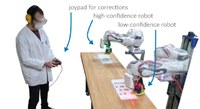Making skilled manufacturing workers more effective through the supervision of multiple robots
Shared autonomy methods, where a human operator and a robot work together, have enabled robots to complete a range of complex and highly variable tasks. Existing work primarily focuses on one human sharing autonomy with a single robot. By contrast, in their paper researchers present an approach for multi-robot shared autonomy that enables one operator to provide real-time corrections across two coordinated robots completing the same task in parallel.
Sharing autonomy with multiple robots presents fundamental challenges. The human can only correct one robot at a time, and without coordination, the human may be left idle for long periods. Accordingly, researchers developed an approach that aligns the robot’s learned motions to best utilize the human’s expertise. The key idea is to leverage Learning from Demonstration (LfD) and time warping to schedule the motions of the robots based on when they may require assistance.
This method uses variability in operator demonstrations to identify the types of corrections an operator might apply during shared autonomy, leverages flexibility in how quickly the task was performed in demonstrations to aid in scheduling, and iteratively estimates the likelihood of when corrections may be needed to ensure that only one robot is completing an action requiring assistance.
Through a preliminary study, the scientists showed that their method can decrease the scheduled time spent sanding by iteratively estimating the times when each robot could need assistance and generating an optimized schedule that allows the operator to provide corrections to each robot during these times.
More information
